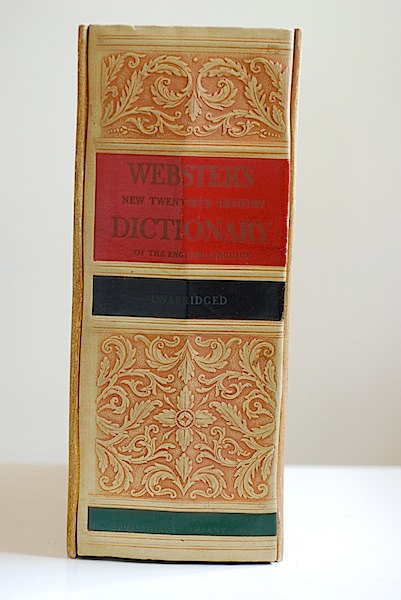Now a decade after her death, I’m still slowly sorting through my mother’s packed up possessions stored in one of our farm outbuildings. Some boxes I am not ready to open, such as the 30 months of letters written by my newlywed father and mother while he fought in several bloody island battles as a Marine in the South Pacific during WWII. Other boxes contain items from too distant an era to be practical in my kitchen, such as the ones labeled “decorative teacups” or “assorted tupperware bowls without lids”.
But I do open the boxes of books. My mother was a high school speech teacher during those war years, and she had a good sense of a classic book, so there are always treasures in those boxes.
Recently I found the 1956 Webster’s New Dictionary of the Twentieth Century that I grew up with. This book was massive, easily weighing 10 pounds, and served as a booster seat for haircuts, a step stool for trying to reach the cookie jar on the kitchen cupboard, and of course, for looking up any obscure word that ever existed in all of history. Or so it seemed.
It was an amazing tome. And as I flipped through the pages, I found some old familiar friends that were neither black nor white nor read all over.
Wildflowers had been carefully pressed between the pages–over two dozen specimens paper thin themselves, their existence squeezed into two dimensions–still showing faint pink or blue, or purple color, almost exuding a long ago fragrance from a summer over fifty years ago. As a child I regularly wandered out to our fields and woods to gather crimson clover blossoms, buttercup, dandelions, daisies, wild violets, wild ginger, calypso lady slippers for bouquets for my mother, and she would select the most perfect to slide between the pages of the dictionary. Occasionally she would pull out one to gently paste on a hand written card she sent to a friend.
Here were my perfect flowers, preserved and pressed for time, just waiting for the fifty-five-years-older me to rediscover them lying between wonderful words that I love to roll in my mouth and type on a page. They are too fragile to paste to a greeting card, or even to handle due to their brittleness. They need to stay right where they are, for another generation or two or three to discover.
I am so pressed for time, becoming more fragile, perhaps more brittle than I care to admit. My mother and father have blown away like the puff ball seeds of the dandelion, on to other horizons, but the sturdy old dictionary is going nowhere. It will be passed down, its delicate passengers preserved inside, a long ago far away summer afternoon of flower gathering to be shared as a great grandchild opens the book to look up a favorite word sometime in the not so far off future.



I, too have cardboard boxes of my parents’ daily letters to each other during WWll, My mother was caring for me and my brother, ages 3 1/2 and 6 months when he left for three years. I was told years ago that there’s a book about love in time of war in them, but I haven’t been able to read them. Although the fact that she saved the letters indicates they knew someone would read them, to do so feels like an intrusion.
LikeLiked by 2 people
What a treasure!
LikeLiked by 2 people
Wonderful!
LikeLiked by 1 person
♥
LikeLiked by 1 person
Very nice. I can relate to your post only too well.
LikeLiked by 1 person
What a wonderful find, Emily.
LikeLiked by 1 person
This is a heartfelt evocative walk through past memories.
As such, it will become more memorable and appreciated
as one link in a family’s continuing history. Timing of the opening and
enjoying the contents of old boxes of artifacts in attics or cellars can be a
bit touchy and may involve a pre-sort of certain finds before being shared.
I wonder if our memories are being saved too often in digital form and not
in the original form – especially those using older paper and ink.
LikeLiked by 1 person
A beautiful and fascinating post that sent me off, in the wee hours, researching “Ode on a Grecian Urn” by John Keats. And I’m now returning to the Land of Nod convinced he was looking over your shoulder as you wrote. Thank you both! To all, a good night.
LikeLiked by 1 person
P.S. Emily: re ‘older paper and ink.’ I meant to add a caveat about aged paper and newsprint memorabilia. They should be taken to a professional photographer who deals in preservation of such materials for evaluation and possible additional reproduction. Otherwise they will not last for future enjoyment. When my father died my mother took all of our precious family-related photos and newspaper articles to be reproduced and placed in a personalized album, complete with her handwritten historical notes and biographical data (mostly saved in our family Bible). What surprised me the most was that even the sepia tintypes from the Civil War and before, including a few very valuable photos of our Gaelic-Irish ancestors taken in Ireland just prior to their emigration to the U.S. The whole project cost her nearly $2000 for her five surviving children’s’ albums, an insignificant amount considering their value to our family history. When her grandchildren (now in their 40s and 50s) come to visit, the ‘album’ is the first thing they ask for.
LikeLiked by 2 people
So beautiful. What a treasure🌾
LikeLiked by 1 person